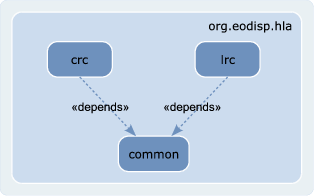EODiSP HLA Design
This page describes the design of the EODiSP HLA software package. For a better understanding, it is recommended to read the EODiSP HLA architecture page first. Additionally, this document is best read in combination with the EODiSP HLA API documentation. This page contains references to classes and interfaces described in the API documentation and describes associations and interactions between them.
Contents
Package Overview
Basically, the RTI design is split into
three packages, namely the crc, lrc and a common
package. The common package defines the remote interfaces of the CRC
and LRC, whereas the other two packages contain the design of the CRC and LRC applications.
The latter two packages depend on the common package but not on each
other. The next figure shows these package dependencies in a UML package diagram.
The design is driven by the IEEE HLA standard. Two interfaces are defined in the
standard: the RTIambassador
and the FederateAmbassador
interface. The RTIambassador is the interface of the runtime infrastructure
as it is seen by a federate. The FederateAmbassador defines the callback
interface of a federate as it is seen by the RTI. The EODiSP HLA or, more precisely,
the LRC implements the RTIambassador interface. The FederateAmbassador
interface needs to be implemented by a federate developer.
The following sections describe the crc and lrc packages
in more detail, including their remote interfaces in the common package.
CRC Package
The central RTI component keeps track of its current federation executions and its joined federates along with their subscriptions and publications of object class attributes and interactions. By design, this information shall only be stored on the CRC and never on the LRC. This centralized approach makes sure that only the most up-to-date information is being accessed by any federate. In practice this means that the LRC does not save (cache) any information about subscriptions and publications of a federate, but always receives this information from the CRC.
The CRC makes available two remote interfaces, the CrcRemote
and FederationExecutionRemote
interfaces. The CrcRemote interface handles general queries not related
to a particular federation execution, whereas the FederationExecutionRemote
interface handles request targeted to a federation execution. Figure 2 shows the
UML diagram of these interfaces.
The core design of the CRC is defined in the crc package. There's one
central class, the Crc class,
from which most other classes and interfaces are reachable. It manages federation
executions, which in turn manage their joined federates. The joined federates hold
the subscriptions and publications of object classes and interactions.
The two remote interfaces, CrcRemote and LrcRemote, are
implemented by dedicated Impl classes. The remote interfaces are not directly
implemented by the core classes (namely, the Crc and FederationExecution)
to make distinguish remote calls from local calls easier and to separate the remote
interfaces from local interfaces/classes. Note that the FederationExecution
class maintains a (strong) reference to the FederationExecutionRemoteImpl
class. This is needed because the remote invocation method infrastructure used with
EODiSP HLA does not use a distributed garbage collector. Having a reference from
a federation execution makes sure that a instance of FederationExecutionRemoteImpl
only gets garbage collected (and thus unexported) when the the federation execution
is destroyed. Otherwise the instance of FederationExecutionRemoteImpl
would possibly be garbage collected too early.
LRC Package
The local RTI component manages one or more local federates. It routes service calls from these local federates to the CRC or to other federates (through their LRCs). An LRC does not save the state of a federation execution or federate but receives all information about subscriptions and publications from the CRC.
The LRC exports two interfaces, the LrcRemote interface (remote) to receive callbacks from the CRC and other LRCs, and the RTIambassador interface (local) to receive service calls from its managed federates. The remote interface is shown in Figure 3.
With the current design, all callbacks from other LRCs and the CRC go through the LrcRemote interface. Another possible approach would have been to export a remote interface for each federate that is managed by the Lrc. However, exporting only one interface allows to transfer data that is needed by more than one local federate only once and then distribute this data to each federate locally.
The implementation of the LrcRemote interface takes the same approach
as the remote interface implementations of the crc package. The LrcRemote
interface is not directly implemented by the Lrc
class but by the LrcRemoteImpl
class. This makes distinction between calls originating from a local federate (through
the RtiAmbassador interface) and calls origination from remote LRCs
or CRCs easier and makes the remote interface independent of other lrc
classes and interfaces.




